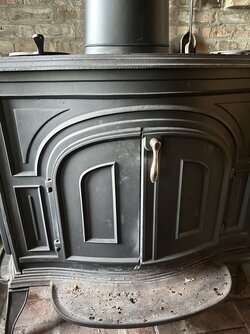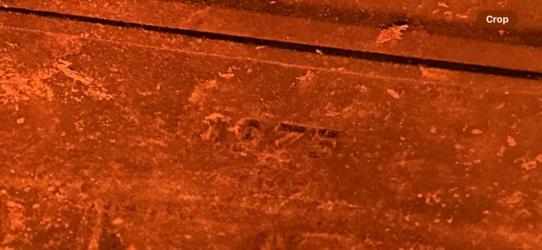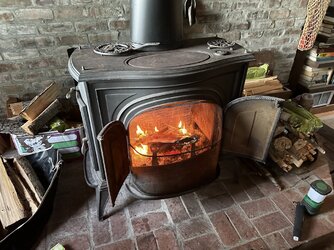Which Defiant is this?
- Thread starter PurpleNurple9
- Start date
-
Active since 1995, Hearth.com is THE place on the internet for free information and advice about wood stoves, pellet stoves and other energy saving equipment.
We strive to provide opinions, articles, discussions and history related to Hearth Products and in a more general sense, energy issues.
We promote the EFFICIENT, RESPONSIBLE, CLEAN and SAFE use of all fuels, whether renewable or fossil.
You are using an out of date browser. It may not display this or other websites correctly.
You should upgrade or use an alternative browser.
You should upgrade or use an alternative browser.
peakbagger
Minister of Fire
Take a look at this, https://www.woodmanspartsplus.com/xref/WoodCoal/VermontCastingsStoves/DefiantIIAIAI0019and0028
Woodsman's is a good place to get parts. My guess is its still being used, its not a 1.
There is a hidden chamber behind the fireback (the casting with 1975 in it). It supposed to be cleaned yearly but few people know its there. If its plugged or partially plugged the stove will not run well if at all when the bypass lever is flipped down, its also a contributor to warped and cracked fireback. Its a PITA to get to. The manual has the instructions. The flue pipe needs to be removed , from there the oval cook plate is removed and then a flap in the smoke shelf is removed and a long thin vacuum cleaner hose is used to clean out the chamber.
Do note, Defiant's were designed for big drafty Vermont homes, the guy who designed it lived in something akin to a barn. They were real popular when they came out and many went in smaller homes where they were vastly oversized. They really like to run, so keeping them running efficiently turned down is a challenge. In most cases, they need to be fed small loads often. If you try to fill them up before bed and crank down the air via the thermostat lever you may learn about backpuffing. If one occurs you will hear a "whoof noise" and the air flap in the back of the stove will fly open and hit the rear shield with a nice solid "click" sound and if you do not have a kettle on the cook plate it may rattle. Most Defiant users have a cast iron pot on top of the cook plate so if there is backpuff the oval plate does not jump out of the stove. A backpuff is effectively a small explosion so its something to be avoided.
Woodsman's is a good place to get parts. My guess is its still being used, its not a 1.
There is a hidden chamber behind the fireback (the casting with 1975 in it). It supposed to be cleaned yearly but few people know its there. If its plugged or partially plugged the stove will not run well if at all when the bypass lever is flipped down, its also a contributor to warped and cracked fireback. Its a PITA to get to. The manual has the instructions. The flue pipe needs to be removed , from there the oval cook plate is removed and then a flap in the smoke shelf is removed and a long thin vacuum cleaner hose is used to clean out the chamber.
Do note, Defiant's were designed for big drafty Vermont homes, the guy who designed it lived in something akin to a barn. They were real popular when they came out and many went in smaller homes where they were vastly oversized. They really like to run, so keeping them running efficiently turned down is a challenge. In most cases, they need to be fed small loads often. If you try to fill them up before bed and crank down the air via the thermostat lever you may learn about backpuffing. If one occurs you will hear a "whoof noise" and the air flap in the back of the stove will fly open and hit the rear shield with a nice solid "click" sound and if you do not have a kettle on the cook plate it may rattle. Most Defiant users have a cast iron pot on top of the cook plate so if there is backpuff the oval plate does not jump out of the stove. A backpuff is effectively a small explosion so its something to be avoided.
Stoney Meadow Maple
Member
That pretty much sums it up , i did convert my D1A1 to D2 but had to have the donor stove there, and new fireback pieces. It is shocking how bad some get and still get used.
stuartG
New Member
This is the same model 1 that I bought at the factory in 1977. The nickel pistol handles are quite rare. My single back cracked in 1979, but I left it alone and it never got worse. The model 1 was manufactured from 1975 to 1980.I’m trying to get my elderly mother’s Vermont Castings Defiant running efficiently and I’m trying to figure out what model it is so I can get the right gaskets. It says 1975 inside, but does not have glass windows. I’m finding conflicting information online.
View attachment 323569 View attachment 323573 View attachment 323574
stuartG
New Member
It requires 12 feet of 5/16" black graphite fiberglass gasket for doors and 4 feet of 5/16" steel reinforced wire mesh gasket for the griddle.This is the same model 1 that I bought at the factory in 1977. The nickel pistol handles are quite rare. My single back cracked in 1979, but I left it alone and it never got worse. The model 1 was manufactured from 1975 to 1980.
Thank you VERY much. Have a great weekendIt requires 12 feet of 5/16" black graphite fiberglass gasket for doors and 4 feet of 5/16" steel reinforced wire mesh gasket for the griddle.
MegoryInVermont
New Member
Oh, that explosion. I will never forget mine! A few months ago. It gave the term "blown a gasket" a whole new understanding for me. In spite of a full cast iron humidifier sitting atop the oval cook plate, the whole thing rose up nearly a foot and slammed back down, completely dislodging the gasket. I had a dang good fire going (too good) so it took me hours to put it out, as smoke continued to pour from the now-loose top plate. Some kinda adventure, I tell ya! I feel so lucky that I witnessed it instead of, say, running to the store. But I am too cautious for that, thank goodness. I came to this site today with the same question... what gasket to buy for replacement. I will check out the replies here.Take a look at this, https://www.woodmanspartsplus.com/xref/WoodCoal/VermontCastingsStoves/DefiantIIAIAI0019and0028
Woodsman's is a good place to get parts. My guess is its still being used, its not a 1.
There is a hidden chamber behind the fireback (the casting with 1975 in it). It supposed to be cleaned yearly but few people know its there. If its plugged or partially plugged the stove will not run well if at all when the bypass lever is flipped down, its also a contributor to warped and cracked fireback. Its a PITA to get to. The manual has the instructions. The flue pipe needs to be removed , from there the oval cook plate is removed and then a flap in the smoke shelf is removed and a long thin vacuum cleaner hose is used to clean out the chamber.
Do note, Defiant's were designed for big drafty Vermont homes, the guy who designed it lived in something akin to a barn. They were real popular when they came out and many went in smaller homes where they were vastly oversized. They really like to run, so keeping them running efficiently turned down is a challenge. In most cases, they need to be fed small loads often. If you try to fill them up before bed and crank down the air via the thermostat lever you may learn about backpuffing. If one occurs you will hear a "whoof noise" and the air flap in the back of the stove will fly open and hit the rear shield with a nice solid "click" sound and if you do not have a kettle on the cook plate it may rattle. Most Defiant users have a cast iron pot on top of the cook plate so if there is backpuff the oval plate does not jump out of the stove. A backpuff is effectively a small explosion so its something to be avoided.
peakbagger
Minister of Fire
I ran my defiant 1 for ten years without a griddle gasket. They had real good castings and that fit on mine is quite tight. With a good draft and a cast iron pot on top of it does not leak smoke. It is not the cause of the puff, its a symptom. Nevertheless, the first time a puff happens its a learning experience. It usually happens in the fall and spring when heating load is lower and people are trying to get it to run at a low rate which it was not designed for. It can be done but its flirting with a puff. Far better to feed it more often with less wood. I have never seen it, but have considered putting a steel bar across the top of the griddle and putting tto catches down under the front and rear flange on the top casting and bolting it down. It might still puff but at least the griddle will not go dancing.
BTW I managed to puff my wood boiler yesterday and I have been running it for 20 years. Full bed of coals but not a lot of flames, I loaded it full with dry wood and about 2 minutes later, I heard a puff but did not see it. The heat from the coals obviously quickly turned the wood into plenty of combustible gases but the fresh combustion air comes from under the coals (its an old coal boiler) so at some point it was full of gases and enough air made it in that it went puff. Far less impressive but a reminder.
BTW puffs are the reason that flue pipes need to be screwed together with 3 screws. You really do not want a puff to blow a joint open.
BTW I managed to puff my wood boiler yesterday and I have been running it for 20 years. Full bed of coals but not a lot of flames, I loaded it full with dry wood and about 2 minutes later, I heard a puff but did not see it. The heat from the coals obviously quickly turned the wood into plenty of combustible gases but the fresh combustion air comes from under the coals (its an old coal boiler) so at some point it was full of gases and enough air made it in that it went puff. Far less impressive but a reminder.
BTW puffs are the reason that flue pipes need to be screwed together with 3 screws. You really do not want a puff to blow a joint open.
Similar threads
- Replies
- 3
- Views
- 1K
- Replies
- 1
- Views
- 584
- Replies
- 4
- Views
- 530
- Replies
- 4
- Views
- 718




